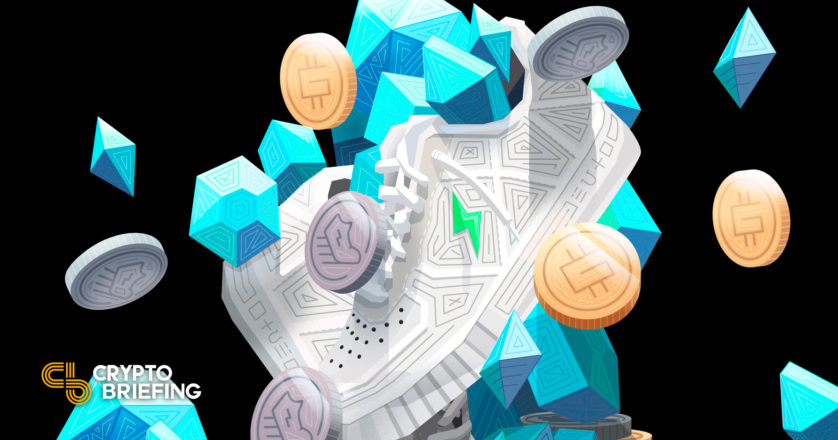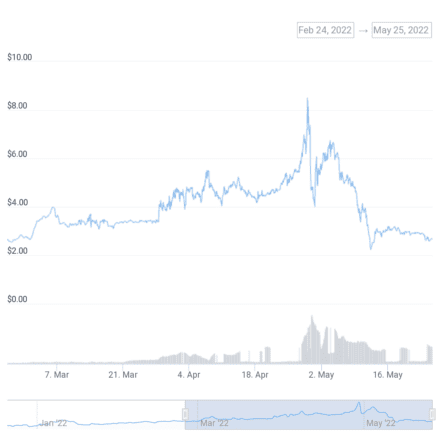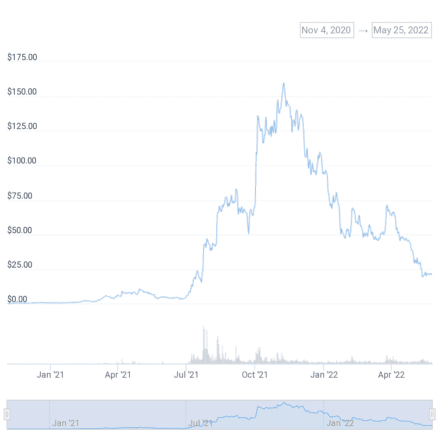Why You Should Be Worried About STEPN
Crypto Briefing takes a look under the hood at the "move-to-earn" hit STEPN, and explores whether its token economy will suffer a similar fate to previous play-to-earn games.

Key Takeaways
- STEPN has soared in popularity, with more than 800,000 daily active users according to the game's developers.
- However, skeptics are starting to question whether STEPN’s token economy is sustainable.
- If STEPN's player growth plateaus its economy will be in danger of entering a death spiral, as has happened with previous play-to-earn games.
Share this article
Interest in the move-to-earn app is soaring. But previous attempts to create crypto game economies indicate that the euphoria isn’t going to last.
The STEPN Story So Far
STEPN’s premise is simple: you get paid to move.
The “move-to-earn” lifestyle app launched with a closed beta in December 2021 and maintained steady growth by onboarding new users through weekly Discord calls and Twitter spaces. STEPN ambassadors would reward engaged community members with pairs of the game’s NFT sneakers, granting them access to start earning Green Satoshi tokens (GST) by running, jogging, or walking around their neighborhoods. At the time, players could make anywhere from $5 to $50 a day, depending on how long they had been playing and how many pairs of sneakers they owned.
As the cold winter months ended, STEPN’s growth accelerated as the prospect of earning valuable tokens for running around outside became even more appealing. The game switched to an open beta, and anyone with an activation code could start playing.
By March, STEPN had amassed more than 100,000 downloads via the Google Play store. Now, the game’s developers boast that it supports over 800,000 daily active users (Dune Analytics data shows the number closer to 90,000), and daily transactions of STEPN’s NFT sneakers are at an all-time high of 264,000. This is important to note because STEPN’s primary source of revenue is generated by taking a 6% cut from trades of its sneaker NFTs on the secondary market. The more NFTs are created and traded, the more money STEPN makes.
STEPN’s fungible tokens have also skyrocketed in recent weeks. The game’s governance token, GMT, reached an all-time high of $4.11 in April after trading for cents a few weeks earlier. GST, earned through playing the game, saw a similar rise, topping out at $8.51 as move-to-earn mania hit a peak in late April.

Although the prices for both tokens have now cooled off, they appear to be holding their value. Since players need GST and GMT to repair and upgrade sneakers, demand should stay high as long as people keep playing.
Is STEPN Sustainable?
As a new crypto project providing lucrative returns to its players, skeptics have questioned whether STEPN’s token economy can continue paying people so handsomely to go on their daily jogs. It’s essential to understand precisely how the game’s mechanics work to understand if STEPN economic model is sustainable.
While players only need a single pair of STEPN’s NFT sneakers to start playing, owning multiple pairs means they can earn more GST token. Sneakers generate energy daily, and every five minutes spent moving converts one point of energy into an amount of GST tokens decided by the sneakers’ efficiency rating.
Players who hold at least two pairs of sneakers can also “mint” new pairs by burning GMT and GST tokens. “Virgin” sneakers that have not been used to mint new shoes need fewer tokens, with the cost increasing every successive mint. After minting seven times, sneakers will no longer be able to mint anymore.
STEPN’s economic structure is similar to that of Axie Infinity, the first play-to-earn game to hit it big. In Axie Infinity, players burn AXS and SLP tokens to “breed” Axies, which are needed to play the game and earn tokens; in STEPN, sneaker minting is the name of the game.
Both Axie Infinity and STEPN rely on new players joining to keep the game profitable for existing ones. If demand for new sneakers dries up, their price on the secondary market will fall. This means fewer new sneakers will get minted, removing buying pressure from GST and GMT. Meanwhile, those already playing the game will continue earning tokens to sell on the open market, driving the value of GMT and GST down in a race to the bottom.
If such a scenario sounds far-fetched, it shouldn’t. This is what happened to Axie Infinity after it surged in popularity during the “NFT summer” of 2021. Token prices and demand for Axies soared as new players entered the game, sped up by gaming guilds renting their Axies out to players who couldn’t afford a set in return for a portion of their earnings. However, with so many players earning and selling the game’s SLP token, its price eroded, making it less attractive for newer players to start.
Eventually, Axie Infinity’s honeymoon period wore off, and the game struggled to retain players. Once the monetary incentives disappeared, and fewer people were playing the game for fun, demand for Axies and the tokens needed to breed them cratered. The price movement of the game’s flagship AXS token encapsulates this story perfectly. AXS soared from $4 last May to an all-time time of $164 in November. Six months later, it’s trading at just over $20.

However, unlike Axie Infinity, STEPN has introduced some new mechanics in an attempt to balance its token economy. GST, the earnable token analogue to Axie Infinity’s SLP, has more uses in the game beyond creating new sneakers. Players need GST to repair sneakers (necessary to continue earning), unlock more sneaker sockets, level up sneakers, and upgrade sneaker gems. While this added utility should help keep demand for GST high and thus increase players’ profits from playing, it does nothing to stop the game from entering a death spiral once player growth plateaus.
Additionally, because STEPN can limit the number of new players entering the game through its invited-based sign-up system, it has more control over how fast it grows. This is integral to managing the STEPN economy. As Twitter user PhABCD recently pointed out, STEPN’s sneaker inflation is currently on track to increase by an unsustainable 31,000% over the next year. To slow down sneaker production, the game’s designers have two options: increase the cost of minting new shoes or decrease demand by slowing user growth.
By managing STEPN’s growth, the designers can stop it from flying too close to the sun for a while. However, there will likely come a time when there won’t be enough new players or minting shoes won’t be profitable enough for existing users. At this point, STEPN’s economy will be in danger of unraveling, which could crash its tokens and NFT sneakers.
Looking to the Future
While it may not happen tomorrow or even next month, previous play-to-earn games show that STEPN’s current model is unsustainable. Unless the game makes drastic changes, a crash is almost inevitable.
With this in mind, it appears that the STEPN team’s primary goal is to keep the game alive for as long as possible to profit from sneaker NFT trading fees. According to a recent TechCrunch article, STEPN currently brings in over $100 million in monthly trading fees. If this keeps up until the STEPN team’s vested GMT tokens start to unlock in January 2023, the game will have made almost as much money as the total value of those tokens at the current price of $1.37. As the team’s tokens unlock incrementally until 2027, there’s a good chance that the majority of its profits will come from trading fees. The value of the vested tokens is almost irrelevant, and they should not be considered proof that the STEPN team has any real skin in the game regarding STEPN’s prolonged success.
Additionally, anyone involved with STEPN appears to be very cagy about who they talk to and who can contact them. Crypto Briefing has tried to contact STEPN team members and ambassadors several times since we first covered the game in March and has not received any response. Instead of talking to crypto-native publications, the game’s creators appear more interested in getting STEPN into Web2 media outlets such as Forbes and TechCrunch. The official email on the STEPN website is unresponsive, and anyone directly associated with the game on Twitter has their direct messages turned off. It almost feels like STEPN is anticipating controversy and is making its operations as water-tight as possible before a coming storm.
Those who started playing STEPN early are raking in tokens and likely up on their initial investments by several orders of magnitude. However, anyone just beginning may find it more difficult to profit going forward. STEPN has certainly made people money and encouraged many more to take up a healthier, more active lifestyle. But will that be enough to retain players when rewards dry up? Let’s see.
Disclosure: At the time of writing this feature, the author owned SOL and several other cryptocurrencies.
